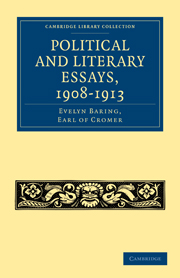II - TRANSLATION AND PARAPHRASE
Published online by Cambridge University Press: 07 September 2011
Summary
“The Edinburgh Review,” July 1913
When Emerson said “We like everything to do its office, whether it be a milch-cow or a rattlesnake,” he assumed, perhaps somewhat too hastily in the latter case, that all the world understands the functions which a milch-cow or a rattlesnake is called upon to perform. No one can doubt that the office of a translator is to translate, but a wide difference of opinion may exist, and, in fact, has always existed, as to the latitude which he may allow himself in translating. Is he to adhere rigidly to a literal rendering of the original text, or is paraphrase permissible, and, if permissible, within what limits may it be adopted? In deciding which of these courses to pursue, the translator stands between Scylla and Charybdis. If he departs too widely from the precise words of the text, he incurs the blame of the purist, who will accuse him of foisting language on the original author which the latter never employed, with the possible result that even the ideas or sentiments which it had been intended to convey have been disfigured. If, on the other hand, he renders word for word, he will often find, more especially if his translation be in verse, that in a cacophonous attempt to force the genius of one language into an unnatural channel, the whole of the beauty and even, possibly, some of the real meaning of the original have been allowed to evaporate.
- Type
- Chapter
- Information
- Political and Literary Essays, 1908–1913 , pp. 54 - 74Publisher: Cambridge University PressPrint publication year: 2010First published in: 1913



